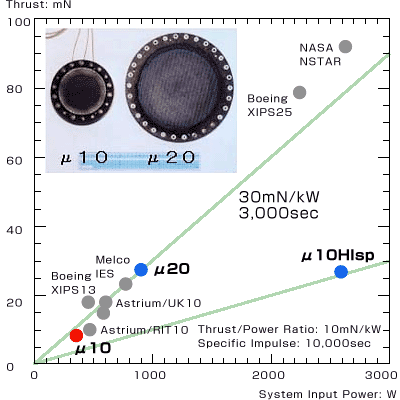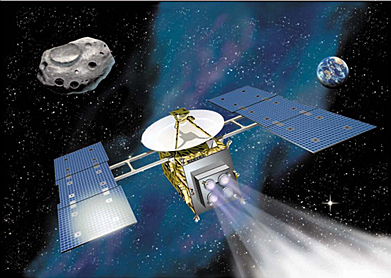
Toward µ20 and further µ10HIsp engine
Space travel is similar to their voyages. Equipped with robust
systems to withstand extremely low temperature and radiation in space, a space
ship calculates its own position based on the angle of the Sun and stars, keeps
its attitude by high speed gyro, identifies direction and distance from the earth
by counting waves of communication radio signal, and collects light instead of
wind. It converts light to electricity and/or directly to kinetic momentum to
obtain thrust.
It is fair to say that the amount of collected light defines the quality of the
space voyage. To gain stronger thrust, more electric power is needed. For this,
we have to collect more light with larger-dimension solar-array panels. When a
large solar-array panel is required but we cannot use it because of its heavy
weight, we use a thin film structure. It is indeed just like a sail. The conversion
of generated electric power to thrust is realized by electric propulsion. (This
is my specialty. So, please allow me to emphasize this point). When organizing
a round-trip mission faster than HAYABUSA or a mission to visit several destinations,
bigger thrust is required. The µ20 engine, larger than the µ10 and currently under
development, is the best for such missions. If planning a much farther space voyage,
faster and stronger jet power is required in order not to increase propellant
consumption. In this case, ion emission with much higher acceleration voltage
is required. If we load twice the propellant of HAYABUSA and use the µ10HIsp engine,
with its three times faster ejection speed, orbital maneuver capability would
be more than 20km/s. This is equivalent to entire capability of launcher. This
is literally a “space ship”.
We, the crew on the ground, pilot the space ship. There is no concern that we
could die of accident or disease. We may feel our lives in danger due to continuous
manpower shortages and hard work day and night, however. This is almost the same
as people in the Age of Geographical Discovery.
 |
Fig. 3 Distribution profile of thrust and power consumption
of the µ-ion engine family
(µ10, µ20, µ10Hisp) and other ion engines in the world |
| |

Fig. 4 Voyage in deep space of the asteroid explorer HAYABUSA
(artistic image)
Toward the boundless, raven-black ocean
The technologies necessary for epic space voyages are already
provided. Let’s build a space ship and set out toward the boundless, raven-black
ocean in order to accomplish our purpose, scientific exploration!
In the circumstances of my daily work deadlines (technical lecture meetings, symposiums,
µ20 technical reports, HAYABUSA space-operation reports, technical proposals,
next-term space-mission proposals, µ10Hisp research plans, research proposals
for the next financial year, and this article), I feel my days are like those
of Columbus who strongly wished to travel to the New World and spent many busy
days looking for a sponsor.
(Hitoshi Kuninaka)
|
![]()







